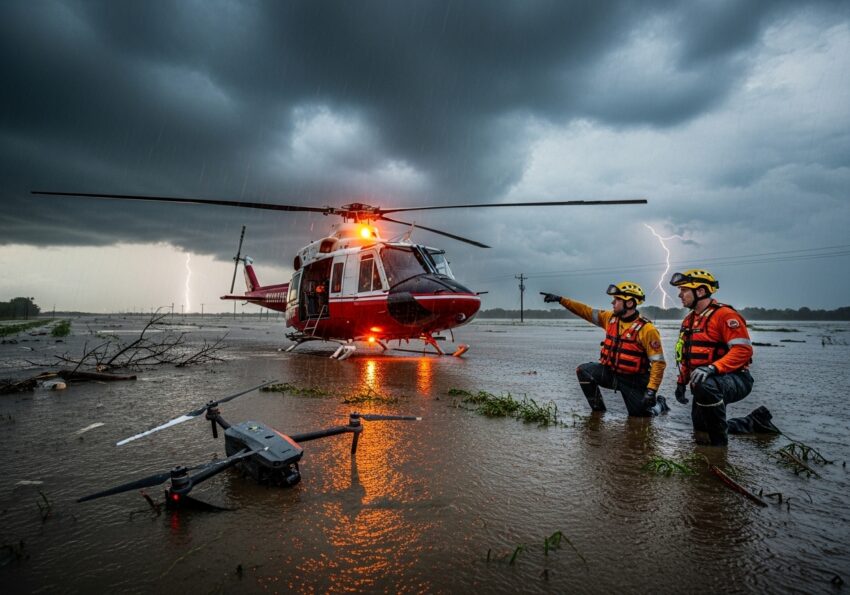America is flying blind—and the danger is growing by the day. While drones have transformed everything from package delivery to emergency response, they’re now fast becoming one of the most underappreciated threats to our national security. Unauthorized drone flights near military bases, airports, and critical infrastructure are surging—and our government is simply not keeping up.
Tom Walker, a former naval officer and CEO of the aviation technology company DroneUp, has issued a stark warning: “They become liabilities, capable of disruption, destruction, and danger.” He’s not overstating the case. This is not science fiction—it’s unfolding in real time.
Just days ago in Texas, during deadly flash floods, a private drone collided with a rescue helicopter in the middle of a life-saving mission. The result? The helicopter was forced to land, grounding a critical asset at the worst possible moment. This wasn’t just an accident—it was a failure of coordination, oversight, and regulation. It could have cost lives.
And it’s not an isolated event. According to the FAA, there were more than 400 illegal drone incursions near U.S. airports in just the first quarter of this year—a 25% jump from the same period in 2024. That’s not just a statistic; that’s a pattern of growing risk.
The problem extends beyond civilian airspace. At military bases across the country, there were 350 unauthorized drone flights in 2024. These aren’t hobbyists getting lost. Many of these flights are organized, persistent, and potentially hostile. In fact, some flights are so strategic and recurring that they raise serious questions about foreign surveillance or sabotage.
Let’s be clear: drones aren’t toys anymore. They’re now cheap, fast, easy to operate, and widely available. That’s a dangerous combination when our detection and enforcement capabilities are stuck in the last decade.
Drones have already been used to smuggle contraband into prisons, spy on energy facilities, and disrupt manned aircraft. The threat is real, and the list of targets is growing—from commercial flights and emergency helicopters to power grids, ports, and correctional facilities.
Walker correctly argues that the crisis isn’t about a lack of technology—it’s a failure of policy. “What we lack is a national framework,” he explains. The tools to manage and secure our skies already exist. What’s missing is the political will and bureaucratic competence to deploy them.
Here’s what needs to happen—and fast.
First, the United States needs a real-time, unified system for tracking low-altitude air traffic. Right now, airspace management is a fragmented mess. Law enforcement, regulators, and drone operators are all working with disconnected systems, often relying on guesswork and outdated data. That’s unacceptable.
Second, the entire drone ecosystem needs to be tied to secure digital identities—cryptographically linked to the pilot, the drone, and the mission. That would prevent spoofing, impersonation, or rogue use. Remote ID systems need to be tamper-proof and enforced with real consequences.
Third, Congress must expand counter-Unmanned Aircraft Systems (c-UAS) authority to include local law enforcement. Right now, the federal government holds the sole authority to engage rogue drones—but that power expires this September. If Congress fails to act, we’ll be stripping local responders of the tools they need to protect their own communities.
And finally, the FAA must publish a mission-priority table to ensure emergency flights—like the one that was grounded in Texas—get immediate airspace access when lives are on the line.
The good news? The technology is ready. The solutions are on the table. What’s missing is urgency. Walker put it bluntly: “We no longer have the luxury of delay.” He’s right.
This is a national security issue. It’s a public safety issue. And it’s a test of whether Washington can finally get ahead of a threat before disaster strikes.
In a world where threats can fly under the radar—literally—we need leadership that doesn’t wait for a tragedy to act. Congress, the FAA, and the entire aviation industry must step up and treat this with the seriousness it demands.
Because the next drone incident might not just delay a flight or ground a helicopter—it could cost American lives.
Click this link for the original source of this article.
Author: rachel
This content is courtesy of, and owned and copyrighted by, https://thebeardedpatriot.com and its author. This content is made available by use of the public RSS feed offered by the host site and is used for educational purposes only. If you are the author or represent the host site and would like this content removed now and in the future, please contact USSANews.com using the email address in the Contact page found in the website menu.








